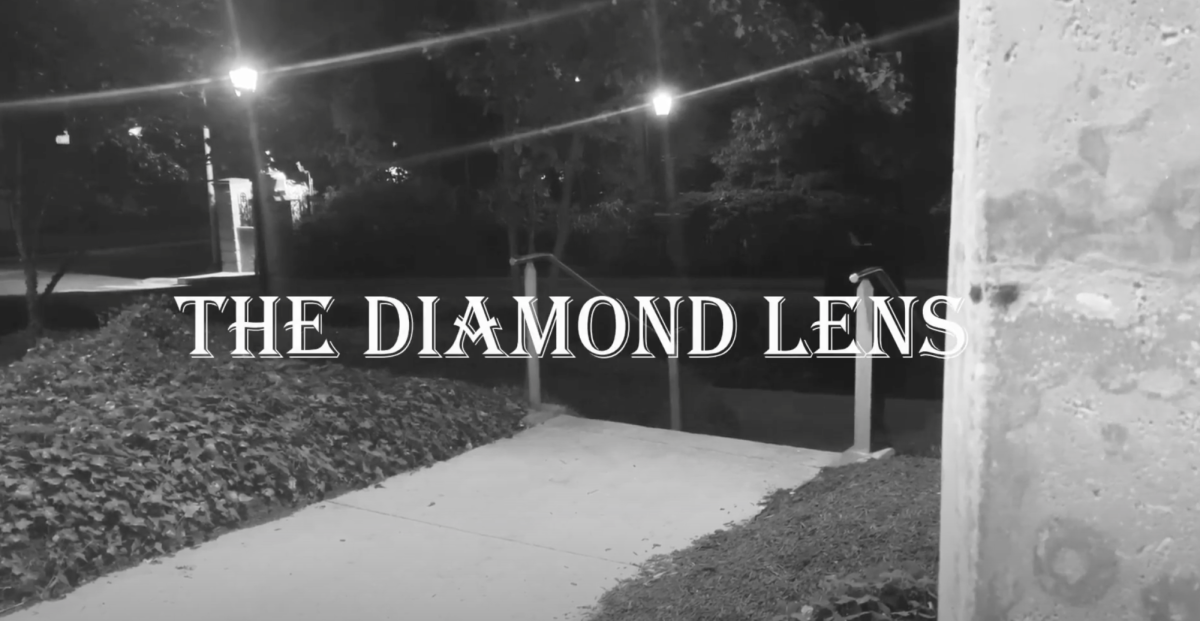The Muse is a creative publication that aims to share the interests, talents, and research of students on campus. The following represents the opinion of the student writer and does not represent the views of Loyola University Maryland, the Greyhound, or Loyola University’s Department of Communication.
One dark night on campus, a man visits his friend, kills him, and is arrested for the crime. Except, this story actually takes place over the course of a month.
“We only probably roughly planned thirty or forty seconds of the murder scene,” third-year director Michael Berger said. “That whole middle we didn’t have anything planned. We do the take, and Owen just nails it.”
Inspired by film noir, Berger and his classmates produced a short film based on “The Diamond Lens” by Fitz James O’Brien for a class project. Equipped with a handful of scene ideas and a largely improvised script, they set out to produce a film in two weeks that quickly turned into a month-long project.
“Some of the narrations are word-for-word excerpts,” said third-year actor and co-director Owen Lawton who plays the protagonist Linley in the film. “Most of the dialogue is pretty much improvised. We cared more about the noir sensibilities of what the movie should look like.”
The film, opening with a shot of Owen walking through campus at night in black and white, utilizes many of the aesthetics of film noir, some aspects more intentional than others.
“Overall, the idea is that we had to shoot at night, especially one day when the moon was out. That was something that was just present from the beginning, and as soon as we put the music to it we were like ‘This feels right to shoot it at night,’” said Berger.
Other aspects were more practical decisions for the sake of the film’s progression.
“Some of the lighting, if I’m being honest, was to cover up,” said Berger. “I was laughing during Owen’s monologue, so I had already turned up the contrast to get that focus on him with the light, but then I saw that you could still make out me smiling, and trying to not die laughing during the fifth take, so I actually upped the contrast even more, so that’s why it has that darker aesthetic.”
The team also took some liberties with the story and film noir genre. Berger discussed leaning more into the tragic element of “The Diamond Lens” with Linely’s paranoia and overconfident self-assurance. At the same time, there had to be a balance between dramatization and comic relief.
“I was really trying to capture that noir protagonist, wise-crack funniness but also not make it too silly. Keep that seriousness,” said Lawton.
The film preserves the aesthetics of film noir while adding subtle humor that does not obscure its effectiveness. It accomplishes a lot on a student budget, and even some of the less polished scenes still hold up to the rest of the film.
“We wanted to be a little self-aware that we were college students making a student film, so I think that’s very much where some of the more funny elements came from,” said Berger.
Liberties with the genre were also taken for the sake of personal interest that ended up blending seamlessly into specific shots. Berger discussed having the idea to put “Moonlight” by Van Morrison behind the single-shot murder sequence, and it worked with minimal editing.
“I think a real blessing in [filmmaking] is that sometimes things just fit, and there are times things don’t, and that is really aggravating, and you have to work around it,” said Berger, “but there are times when it finally clicks, and it’s really rewarding, especially to see that onscreen and see people really like that.”
Lawton said one of his favorite scenes was when Linley walks down the hallway with the camera following him, and he closes the door in its face before it pans upward.
“We kind of stole that from “Evil Dead” because me and Berger really like those movies,” said Lawton. “We were like ‘It’s not noir at all, but wouldn’t it be great if we had a little tracking shot of me throughout the hallway.’ It’s just taking little stuff from movies we like and incorporating that into our own.”
The film ends with Lawton’s piercing eye contact with the camera as Linley is arrested for murder, and the narrative finally catches up to the present with the audience’s horrific realization of what they’ve just witnessed. The narrative has a mirror effect in which the reliance on Linley’s recollection at the beginning is discredited by the final scene, adding to the tragic element the team was going for. This retrospective quality forces the audience to reconsider Linley’s present character.
“The point where we wanted the story to be told from was right there. It’s right where the character’s getting locked up because he’s been caught,” said Lawton. “The story starts here even though the story you’re seeing starts in a different place.”







































































































